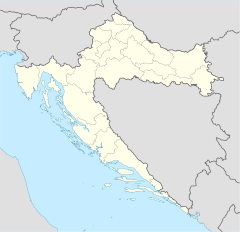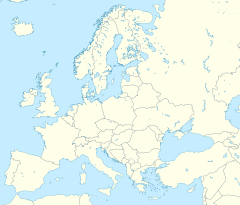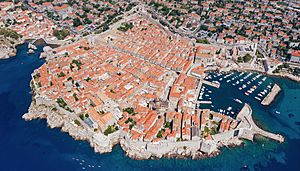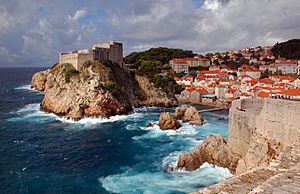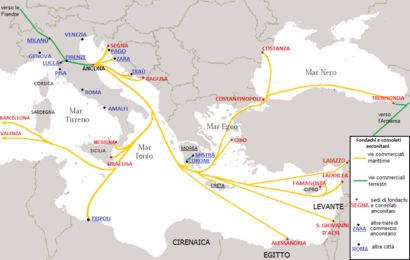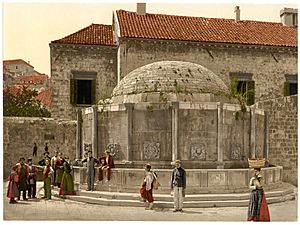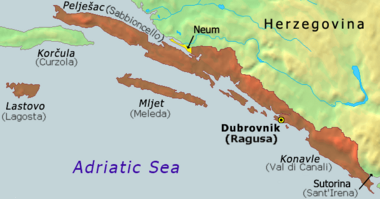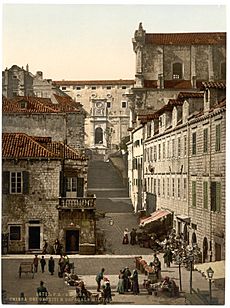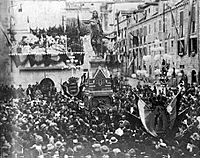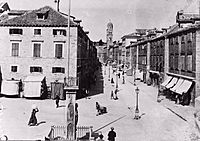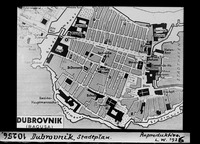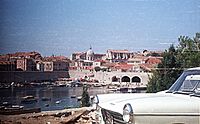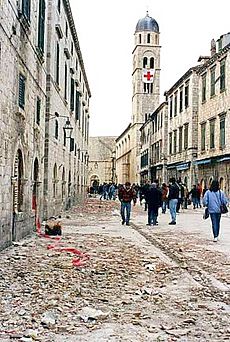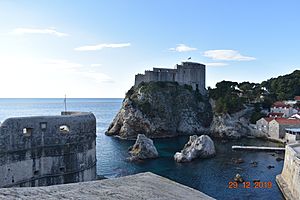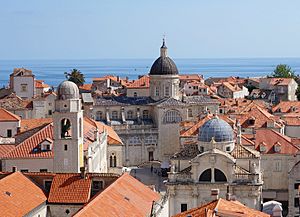Dubrovnik facts for kids
Quick facts for kids
Dubrovnik
Ragusa
|
|||
|---|---|---|---|
| Grad Dubrovnik City of Dubrovnik |
|||
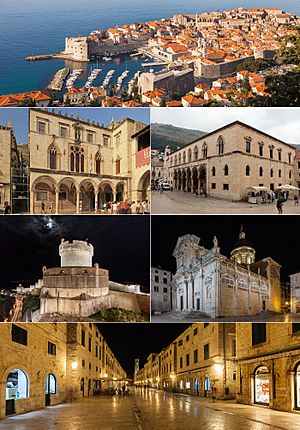
Clockwise from top: Dubrovnik Old Town, Rector's Palace, Dubrovnik Cathedral, Stradun, Walls of Dubrovnik, Sponza Palace
|
|||
|
|||
| Nicknames:
"Pearl of the Adriatic", "Thesaurum mundi"
|
|||
| Country | Croatia | ||
| County | Dubrovnik-Neretva | ||
| Government | |||
| • Type | Mayor-Council | ||
| Area | |||
| • City | 142.6 km2 (55.1 sq mi) | ||
| • Urban | 12.1 km2 (4.7 sq mi) | ||
| Elevation | 3 m (10 ft) | ||
| Population
(2021)
|
|||
| • City | 41,562 | ||
| • Density | 291.46/km2 (754.87/sq mi) | ||
| • Urban | 26,922 | ||
| • Urban density | 2,225/km2 (5,763/sq mi) | ||
| Time zone | UTC+1 (CET) | ||
| • Summer (DST) | UTC+2 (CEST) | ||
| Postal code |
HR-20 000
|
||
| Area code(s) | +385 20 | ||
| Vehicle registration | DU | ||
| Patron saint | Saint Blaise | ||
| UNESCO World Heritage Site | |||
| Official name | Old City of Dubrovnik | ||
| Criteria | Cultural: (i)(iii)(iv) | ||
| Inscription | 1979 (3rd Session) | ||
| Area | 96.7 ha (239 acres) | ||
Dubrovnik (pronounced dyuu-BROV-nik), also known as Ragusa in the past, is a beautiful city in southern Croatia. It sits right by the Adriatic Sea. Dubrovnik is a very popular place for tourists in the Mediterranean. It is also a busy seaport and the main city of the Dubrovnik-Neretva County.
In 2021, about 41,562 people lived there. In 1979, UNESCO added Dubrovnik to its list of World Heritage Sites. This was because of its amazing old buildings and strong city walls.
The city's history likely began in the 7th century. It was founded by people escaping from another city called Epidaurum. For a long time, Dubrovnik was protected by the Byzantine Empire and then by the Republic of Venice. From the 14th to the 19th centuries, Dubrovnik was a free state.
Dubrovnik became rich through sea trade. As the capital of the Republic of Ragusa, it grew a lot, especially in the 15th and 16th centuries. It was known for its wealth and clever diplomacy. During this time, Dubrovnik also became a center for Croatian literature.
A huge earthquake in 1667 almost destroyed the whole city. Later, during the Napoleonic Wars, French forces took over Dubrovnik. The Republic of Ragusa was ended and became part of other states. In the 19th and early 20th centuries, Dubrovnik was part of the Austrian Empire.
Dubrovnik then joined the Kingdom of Yugoslavia in 1918. During World War II, it was part of a state linked to the Axis powers. After the war, it became part of SFR Yugoslavia.
In 1991, during the Croatian War of Independence, Dubrovnik was attacked. The Yugoslav People's Army surrounded it for seven months. Many buildings were damaged by shelling. After the war, the city was repaired and rebuilt. It became a top tourist spot again. It is also a popular place for filming movies and TV shows. Today, Dubrovnik is very popular with tourists. Some say it has too many visitors for its size.
Contents
- Discovering Dubrovnik's Names
- A Journey Through Dubrovnik's Past
- Geography of Dubrovnik
- Dubrovnik's Rich Heritage
- Dubrovnik's Population
- Getting Around Dubrovnik
- Learning in Dubrovnik
- Sports in Dubrovnik
- Panoramic View of Dubrovnik
- Famous People from Dubrovnik
- Sister Cities of Dubrovnik
- Awards and Honors
- Images for kids
- Related pages
- See also
Discovering Dubrovnik's Names
The names Dubrovnik and Ragusa were both used for many centuries. Ragusa was the official name of the Republic of Ragusa until 1808. It was also the city's name in the Kingdom of Dalmatia until 1918.
The name Dubrovnik first appeared in the late 12th century. It became widely used by the 16th or 17th century. The name Dubrovnik likely comes from an old Slavic word for 'oak'. It means 'oak wood' or 'oak forest'.
The name Ragusa comes from a Greek word. It was recorded in the 10th century. People have tried to explain where the name came from. Some ideas include words for "grape" or "narrow passage".
An old story from the 10th century explains the name Ragusa. It says the city was built on a rocky island called Lausa. This was by people who escaped from another city destroyed by Slavs. The name Ragusa might be a changed form of Lausa.
A Journey Through Dubrovnik's Past
How Dubrovnik Began
In ancient times, the Illyrian tribe of Pleraei lived in the area of Dubrovnik. According to old writings from around 950 AD, Ragusa was founded in the 7th century. It was built on a "rocky island" by people escaping from a Roman city called Epidaurum. That city was destroyed by Slavs and Avars. Dubrovnik became one of the Dalmatian city-states.
In 2007, archaeologists found an old Byzantine church from the 8th century. They also found parts of the city walls. The size of the church shows that a large settlement was there. Ancient coins from the 3rd and 2nd centuries BC were also found. This means people lived there even before Christianity.
One theory suggests Greek sailors founded Dubrovnik. They might have used it as a stop between two other Greek settlements.
The Republic of Ragusa: A Free State
After the fall of the Ostrogothic Kingdom, Dubrovnik was protected by the Byzantine Empire. In the 12th and 13th centuries, Dubrovnik became a republic ruled by a few powerful families. It grew rich by trading with the Serbian state.
In 1205, Dubrovnik came under the rule of Venice. Venice influenced the city's government. In 1358, Dubrovnik gained more independence. It became a state that paid tribute to the Kingdom of Hungary. The city expanded further in 1333. The Serbian emperor sold some land to Dubrovnik.
From the 14th century until 1808, Dubrovnik was a free state. It paid a yearly tribute to the Ottoman Empire from 1382 to 1804. The Republic was strongest in the 15th and 16th centuries. Its sea power was as great as Venice's.
For many years, Dubrovnik was friends with Ancona, another port city. They both competed with Venice for control of the Adriatic Sea. This friendship helped them stop Venice from controlling all trade. Ancona and Dubrovnik created a new trade route. It went from Dubrovnik to Ancona, through Florence, and ended in Flanders.
Dubrovnik had its own laws, called Statutes, in 1272. These laws included rules for city planning. They also had rules for quarantine to stop diseases.
The Republic was very advanced for its time. A medical service started in 1301. The first pharmacy opened in 1317 and still works today. An almshouse for the poor opened in 1347. The first quarantine hospital was set up in 1377.
Slave trading was stopped in 1418. An orphanage opened in 1432. A 20-kilometer water system was built in 1438. It was designed by Onofrio della Cava. He also built two public fountains.
The city was run by noble families. They kept a strict system of social classes. The Republic valued freedom very much. It managed to stay independent between Venice and the Ottoman Empire for centuries.
Latin was the official language until 1472. As more Slavic people moved in, Croatian became widely spoken. The government tried to ban Slavic languages in official meetings. But Croatian became more common in daily life and literature. Dubrovnik became a center for Croatian writing.
The Republic's wealth came from its land and sea trade. Dubrovnik merchants traveled freely with their large fleet of merchant ships. They traded all over the world. They even started settlements in places like India and America. One secret to their success was trading, not conquering. They sailed under a white flag with the word Libertas (freedom) on it. This flag was adopted when slave trading ended in 1418.
Many Jewish people who had converted to Christianity moved to Dubrovnik. In 1544, a ship arrived full of Portuguese refugees. Dubrovnik also had a colony in Fes, Morocco.
Dubrovnik paid tribute to the Ottoman Empire. This gave them benefits, like access to the Black Sea. They paid less customs duties and had the Turks' support in trade disputes. This also helped them trade with inland regions.
The Republic slowly became weaker. This was due to problems with shipping in the Mediterranean. A terrible earthquake in 1667 also caused great damage. Over 5,000 people died, and most public buildings were destroyed. In 1699, the Republic had to sell some land to the Ottomans. This was to avoid conflict with Venetian forces. This land is now part of Bosnia and Herzegovina.
Later Years and Changes
On May 27, 1806, French forces took over Dubrovnik. They entered the city by tricking the leaders. In 1808, the Republic of Ragusa was officially ended. Its land became part of the French Empire's states. The French general in charge was even named "Duke of Ragusa."
After seven years, the people of Dubrovnik rose up against the French. They were helped by British forces. They surrounded the occupied city. The British navy helped by controlling the sea. Soon, people inside the city joined the fight. The Austrian Empire sent troops to help. But their real goal was to take over Dubrovnik themselves. They managed to enter the city and take control.
The flag of Saint Blaise, Dubrovnik's patron saint, was flown. But it was taken down after only two days by Austrian order. The Austrians wanted to control the entire eastern Adriatic coast. They worked to make sure Dubrovnik would not become a republic again. Dubrovnik's representative was not allowed to speak at the Congress of Vienna. This was despite old treaties promising Dubrovnik's freedom.
Languages Spoken
The official language until 1472 was Latin. As more Slavic people moved from inland, Croatian became widely spoken. In fact, it was often just called "Slavic" in old documents. To try and stop this change, the government tried to ban Slavic languages in official meetings. Old Glagolitic tablets have been found near Dubrovnik. This shows that the Glagolitic script was also used there.
Italian was also spoken, especially by the upper classes. It was influenced by the Venetian and Tuscan dialects. This happened because of Venice's strong influence.
Under Austrian Rule
When the Austrian Empire took over in 1815, they set up a new government. They created the Kingdom of Dalmatia. This region had its own parliament. The Austrians tried to centralize everything. They wanted to change how taxes, religion, education, and trade worked. These changes mostly failed.
After the Napoleonic Wars, new movements began. People wanted to reorganize the region based on national groups. Dalmatia was ruled by German-speaking Austrians. The local leaders spoke both Croatian and Italian. Most people were Slavic Catholics, with a smaller group of Slavic Orthodox. This made things complicated.
In 1815, the old Dubrovnik government met for the last time. They tried to bring back the Republic, but it didn't work. The Austrian Empire recognized most of the old noble families.
Later, important local leaders were elected. Count Rafael Pucić was elected Mayor of Dubrovnik several times. He also served in the Dalmatian Council. In 1905, a committee was formed to start electric tram service. Trams ran in Dubrovnik from 1910 to 1970.
Dubrovnik in Yugoslavia (1918–1991)
After the Austro-Hungarian Empire fell in 1918, Dubrovnik became part of the new Kingdom of Serbs, Croats, and Slovenes. This country was later renamed Kingdom of Yugoslavia. Dubrovnik became one of its regions. In 1939, it became part of the Banovina of Croatia.
During World War II, Dubrovnik was part of a state linked to the Axis powers. It was first occupied by the Italian Army, then by the German Army. In October 1944, Yugoslav Partisans freed Dubrovnik. After the war, many Italian people from Dubrovnik moved to Italy.
Under communism, Dubrovnik became part of SR Croatia within SFR Yugoslavia. After World War II, the city became a popular tourist spot. Even more so after 1979, when it became a World Heritage Site. Tourism money helped the city grow. The Dubrovnik Summer Festival started in 1950. A major highway, the Adriatic Highway, opened in 1965. This connected Dubrovnik to other cities and boosted tourism.
The Siege of Dubrovnik and Its Aftermath
In 1991, Croatia and Slovenia declared their independence from Yugoslavia. The Yugoslav People's Army (JNA), mostly made up of Serbs, attacked Dubrovnik. This happened even though the Old Town had been declared a demilitarized zone in the 1970s. The new Croatian government set up a military post in the city.
On October 1, 1991, the JNA attacked Dubrovnik. This led to a siege that lasted seven months. The heaviest attack was on December 6. During the conflict, 114 civilians were killed. Artillery attacks damaged 56% of the buildings. The historic walled city, a UNESCO World Heritage Site, was hit 650 times.
The Croatian Army ended the siege in May 1992. They freed the areas around Dubrovnik by October. However, the city remained at risk of attacks for three more years.
After the war, the damage to the Old Town was repaired. The repairs followed UNESCO guidelines. Most of the rebuilding happened between 1995 and 1999. You can still see a map near the city gate showing where the artillery hit. New, brighter roofs also show where repairs were made.
The International Criminal Tribunal for the former Yugoslavia (ICTY) charged JNA generals for the bombing. General Pavle Strugar was sentenced to prison for his role in the attack.
Dubrovnik in Modern Croatia
In October 2023, Dubrovnik joined the European Network of Saint James Way Paths. A new pilgrimage route, "Camino Dubrovnik-Međugorje," is expected to open in May 2024.
Geography of Dubrovnik
Dubrovnik is located at the southern tip of the Dalmatia region. It is in Croatia and sits on the Adriatic Sea. It is part of the Dubrovnik-Neretva County. The city borders the municipality of Dubrovačko Primorje to the north.
Islands Near Dubrovnik
There are several islands off the coast of Dubrovnik. These are part of the Elaphiti Islands group. Some of the larger, populated islands include:
- Šipan
- Lopud
- Koločep
Another island often linked to the Elaphiti Islands is Lokrum. Most of the other islands are not inhabited.
Dubrovnik's Climate
Dubrovnik has a Mediterranean climate. This means it has hot, humid, and fairly dry summers. The winters are mild to cool and wet. The bora wind brings cold gusts from October to April. Thunderstorms can happen all year, even in summer.
Temperatures can vary slightly depending on the area. In July and August, daytime temperatures usually reach about 28°C (82°F). At night, they drop to around 23°C (73°F). In spring and autumn, temperatures are typically between 20°C (68°F) and 28°C (82°F). Dubrovnik has the mildest winters of any Croatian city. Daytime temperatures in the coldest months are around 13°C (55°F). Snow is very rare in Dubrovnik.
| Climate data for Dubrovnik (1971–2000, extremes 1961–2019) | |||||||||||||
|---|---|---|---|---|---|---|---|---|---|---|---|---|---|
| Month | Jan | Feb | Mar | Apr | May | Jun | Jul | Aug | Sep | Oct | Nov | Dec | Year |
| Record high °C (°F) | 18.4 (65.1) |
24.1 (75.4) |
26.8 (80.2) |
30.2 (86.4) |
32.9 (91.2) |
37.3 (99.1) |
37.9 (100.2) |
38.6 (101.5) |
33.5 (92.3) |
30.5 (86.9) |
25.4 (77.7) |
20.3 (68.5) |
38.4 (101.1) |
| Mean daily maximum °C (°F) | 12.3 (54.1) |
12.6 (54.7) |
14.4 (57.9) |
16.9 (62.4) |
21.5 (70.7) |
25.3 (77.5) |
28.2 (82.8) |
28.5 (83.3) |
25.1 (77.2) |
21.1 (70.0) |
16.6 (61.9) |
13.4 (56.1) |
19.7 (67.5) |
| Daily mean °C (°F) | 9.2 (48.6) |
9.4 (48.9) |
11.1 (52.0) |
13.8 (56.8) |
18.3 (64.9) |
22.0 (71.6) |
24.6 (76.3) |
24.8 (76.6) |
21.4 (70.5) |
17.6 (63.7) |
13.3 (55.9) |
10.3 (50.5) |
16.3 (61.3) |
| Mean daily minimum °C (°F) | 6.6 (43.9) |
6.8 (44.2) |
8.4 (47.1) |
11.0 (51.8) |
15.3 (59.5) |
18.9 (66.0) |
21.4 (70.5) |
21.6 (70.9) |
18.4 (65.1) |
14.9 (58.8) |
10.7 (51.3) |
7.8 (46.0) |
13.5 (56.3) |
| Record low °C (°F) | −7.0 (19.4) |
−5.2 (22.6) |
−4.2 (24.4) |
1.6 (34.9) |
5.2 (41.4) |
10.0 (50.0) |
14.1 (57.4) |
14.1 (57.4) |
8.5 (47.3) |
4.5 (40.1) |
−1.0 (30.2) |
−6.0 (21.2) |
−7.0 (19.4) |
| Average precipitation mm (inches) | 98.3 (3.87) |
97.9 (3.85) |
93.1 (3.67) |
91.4 (3.60) |
70.1 (2.76) |
44.0 (1.73) |
28.3 (1.11) |
72.5 (2.85) |
86.1 (3.39) |
120.1 (4.73) |
142.3 (5.60) |
119.8 (4.72) |
1,064 (41.89) |
| Average precipitation days (≥ 0.1 mm) | 11.2 | 11.2 | 11.2 | 12.0 | 9.4 | 6.4 | 4.7 | 5.1 | 7.2 | 10.8 | 12.4 | 12.0 | 113.6 |
| Average relative humidity (%) | 59.9 | 58.4 | 61.2 | 64.2 | 66.7 | 63.8 | 58.2 | 59.2 | 61.9 | 62.2 | 62.4 | 60.3 | 61.5 |
| Mean monthly sunshine hours | 130.2 | 142.8 | 179.8 | 207.0 | 266.6 | 312.0 | 347.2 | 325.5 | 309.0 | 189.1 | 135.0 | 124.0 | 2,668.2 |
| Source: Croatian Meteorological and Hydrological Service | |||||||||||||
| Climate data for Dubrovnik | |||||||||||||
|---|---|---|---|---|---|---|---|---|---|---|---|---|---|
| Month | Jan | Feb | Mar | Apr | May | Jun | Jul | Aug | Sep | Oct | Nov | Dec | Year |
| Average sea temperature °C (°F) | 14.1 (57.4) |
14.2 (57.6) |
14.4 (57.9) |
15.6 (60.1) |
18.7 (65.7) |
23.1 (73.6) |
25.5 (77.9) |
25.4 (77.7) |
24.3 (75.7) |
20.7 (69.3) |
18.2 (64.8) |
15.7 (60.3) |
19.2 (66.5) |
| Mean daily daylight hours | 9.0 | 11.0 | 12.0 | 13.0 | 15.0 | 15.0 | 15.0 | 14.0 | 12.0 | 11.0 | 10.0 | 9.0 | 12.2 |
| Average Ultraviolet index | 1 | 2 | 4 | 5 | 7 | 8 | 9 | 8 | 6 | 4 | 2 | 1 | 4.8 |
| Source: Weather Atlas | |||||||||||||
Dubrovnik's Rich Heritage
| Old City of Dubrovnik | |
|---|---|
| Native name Croatian: Stari grad Dubrovnik |
|
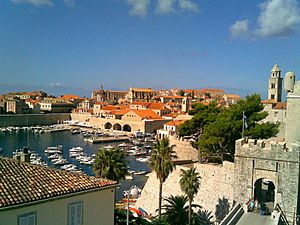
The Old Harbour at Dubrovnik
|
|
| Location | Dubrovnik-Neretva County, Croatia |
| Type | Cultural |
| Criteria | i, iii, iv |
| Designated | 1979 (3rd Session) |
| Reference no. | 95 |
| Extension | 1994 |
| Endangered | 1991–1998 |
|
Cultural Good of Croatia
|
|
| Official name: Stari grad Dubrovnik | |
The annual Dubrovnik Summer Festival is a big cultural event. It lasts 45 days and features plays, concerts, and games. It has won awards for its quality.
The city's patron saint is Sveti Vlaho (Saint Blaise). His statues are seen all over the city. February 3 is his feast day. Every year, Dubrovnik celebrates with parades and festivities.
The Old Town of Dubrovnik is shown on the back of the Croatian 50 kuna banknote. This banknote was issued in 1993 and 2002.
The city has many old buildings. The Arboretum Trsteno is the oldest arboretum (a garden for trees) in the world. It was started before 1492. Dubrovnik also has the third-oldest European pharmacy. It opened in 1317 and is still working today. It is located at the Little Brothers monastery.
The writer George Bernard Shaw visited Dubrovnik in 1929. He famously said, "If you want to see heaven on earth, come to Dubrovnik."
In the bay of Dubrovnik is the wooded island of Lokrum. Legend says Richard the Lionheart, King of England, landed there after a shipwreck in 1192. The island has a fortress, a botanical garden, and a monastery.
Dubrovnik has several beaches. Banje is the main public beach. Copacabana Beach is a stony beach on the Lapad peninsula. It is named after the famous beach in Rio de Janeiro.
By 2018, the city started taking steps to manage the large number of tourists. Especially in the Old Town. One way was to spread out the arrival times of cruise ships. This helps to make sure not too many visitors arrive at once. In 2023, the mayor banned wheeled luggage in the Old Town. This was to reduce noise on the old paved streets.
Important Historical Buildings
Few of Dubrovnik's Renaissance buildings survived the 1667 earthquake. But enough remained to show the city's amazing architecture. The Sponza Palace is a beautiful Renaissance building from the 16th century. It now holds the National Archives. The Rector's Palace is a Gothic-Renaissance building. It has finely carved details and a grand staircase. It is now a museum. Its front is also shown on the Croatian 50 kuna banknote. The St. Saviour Church is another Renaissance building. It is next to the popular Franciscan Church and Monastery. The Franciscan monastery's library has many old books and documents.
Dubrovnik's most loved church is St Blaise's church. It was built in the 18th century to honor the city's patron saint. The city's Baroque Cathedral was also built in the 18th century. It has an impressive Treasury with relics of Saint Blaise. The city's Dominican Monastery looks like a fortress from the outside. But inside, it has an art museum and a Gothic-Romanque church. Its library has many old books and valuable manuscripts.
The architect Onofrio della Cava built a water supply system in 1438. He also built two public fountains. The Big Onofrio's Fountain is near the Pile Gate. Water flows from sixteen carved faces. The Little Onofrio's Fountain is on the eastern side of the main street. It supplied water to the market.
The 31-meter (102-foot) Dubrovnik Bell Tower was built in 1444. It is a symbol of the free city of Ragusa. It was rebuilt in 1929 because it was unstable. The clock face shows the phases of the moon. Two figures strike the bell every hour. The tower stands next to the House of the Main Guard.
In 1418, the Republic of Ragusa put up a statue of Roland. This showed their loyalty to Sigismund, the Holy Roman Emperor. Roland statues were common symbols of city freedom. The sculptor Bonino of Milano made the current Gothic statue in 1419. Its forearm was used as a unit of measure in Dubrovnik. One ell of Dubrovnik was 51.2 cm (20.2 inches).
The Famous Walls of Dubrovnik
One of Dubrovnik's most famous features is its walls. They stretch almost 2 kilometers (1.2 miles) around the city. The walls are 4 to 6 meters (13 to 20 feet) thick on the land side. They are thinner on the sea side. The towers and turrets were built to protect the city. The walls of Dubrovnik have also been used as a filming location. They were used for the fictional city of King's Landing in the TV series Game of Thrones.
Dubrovnik's Population
| Historical populations of Dubrovnik |
||
|---|---|---|
| Year | Pop. | ±% |
| 1880 | 15,666 | — |
| 1890 | 15,329 | −2.2% |
| 1900 | 17,384 | +13.4% |
| 1910 | 18,396 | +5.8% |
| 1921 | 16,719 | −9.1% |
| 1931 | 20,420 | +22.1% |
| 1948 | 21,778 | +6.7% |
| 1953 | 24,296 | +11.6% |
| 1961 | 27,793 | +14.4% |
| 1971 | 35,628 | +28.2% |
| 1981 | 46,025 | +29.2% |
| 1991 | 51,597 | +12.1% |
| 2001 | 43,770 | −15.2% |
| 2011 | 42,615 | −2.6% |
| Source: Naselja i stanovništvo Republike Hrvatske 1857–2001, DZS, Zagreb, 2005 | ||
In 2011, the total population of Dubrovnik was 42,615. This number was down from 49,728 in 1991. The population is spread across several settlements. The main city of Dubrovnik had 28,434 people. Other settlements include Mokošica and Nova Mokošica.
According to the 2011 census, most people in Dubrovnik are Croat (90.34%). Other groups include Bosniak (3.52%), Serb (2.73%), and Albanian (0.51%).
Getting Around Dubrovnik
Dubrovnik has its own international airport. It is about 20 kilometers (12 miles) southeast of the city center. Buses connect the airport to the main bus station in Gruž. There is also a network of modern local buses. These buses connect all Dubrovnik neighborhoods. They run often from early morning until midnight.
Unlike other major Croatian cities, Dubrovnik does not have a train connection. In the past, until 1975, there was a narrow-gauge railway. It connected Dubrovnik to Mostar and Sarajevo.
The A1 highway is planned to extend to Dubrovnik. Currently, it goes between Zagreb and Ploče. Because the area around Dubrovnik is separated from the rest of Croatia, the highway will either cross the Pelješac Bridge. This bridge was finished in 2022. Or it will go through Neum in Bosnia and Herzegovina.
Learning in Dubrovnik
Dubrovnik has several places for higher education. These include the University of Dubrovnik. There is also the Libertas University. Another option is the Rochester Institute of Technology Croatia. The University of Zagreb also has a postgraduate study center here. An Institute of History is part of the Croatian Academy of Sciences and Arts.
Sports in Dubrovnik
Dubrovnik will host the 2025 World Men's Handball Championship. This will happen at a new arena. The city will share hosting duties with Denmark and Norway.
The local football club is NK GOŠK Dubrovnik. They have played in the third level of Croatian football for many years.
The local water polo club is VK Jug. It is one of the most successful clubs in Croatian history. Many of its players are on the Croatia national water polo team.
Panoramic View of Dubrovnik
Famous People from Dubrovnik
- Marin Držić (1508–1567), a famous playwright and poet.
- Ivan Gundulić (1589–1638), a well-known writer and poet.
- Ruđer Josip Bošković (1711–1787), a physicist, astronomer, and mathematician.
- Tereza Kesovija (born 1938), a popular pop and classical singer.
- Andro Knego (born 1956), an Olympic and World champion basketball player.
- Miho Bošković (born 1983), an Olympic, World, and European champion water polo player.
- Mario Hezonja (born 1995), a basketball player.
- Ana Konjuh (born 1997), a tennis player.
Sister Cities of Dubrovnik
Dubrovnik has many sister cities around the world, including:
- Bad Homburg vor der Höhe, Germany
- Beyoğlu, Turkey
- Graz, Austria
- Helsingborg, Sweden
- Imotski, Croatia
- Monterey, United States
- Ragusa, Italy
- Ravenna, Italy
- Rueil-Malmaison, France
- Sanya, China
- Sarajevo, Bosnia and Herzegovina
- Sorrento, Italy
- Venice, Italy
- Vukovar, Croatia
Awards and Honors
Dubrovnik was named one of the 25 Most Beautiful Cities in the World by Travel + Leisure magazine. It was ranked 18th on the list.
Honorary Citizens of Dubrovnik
The Dubrovnik City Council has named several people as honorary citizens:
- Kathy Wilkes (1991-1992)
- Ivan Supek (1997)
- Pope John Paul II (2003)
- Christopher Patten (2004)
- Stjepan Mesić (2009)
- Ante Gotovina (2012)
- Francesco Cossiga (2023)
Images for kids
Related pages
See also
 In Spanish: Dubrovnik para niños
In Spanish: Dubrovnik para niños




